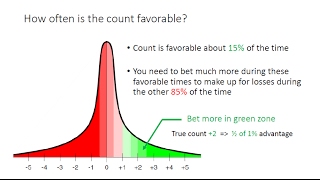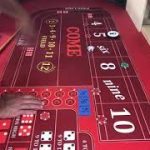Learn Blackjack Video Source & Info:
Does card counting really work? You win by betting more when the remaining deck is favorable, allowing you to gain an overall advantage and win in the long run. However, you need to risk very large amounts to win just a little, making it impractical as a way to earn money unless you have a huge bankroll that you’re willing to risk over an extended period of time.
If you would rather read about this than watch a video, go to the companion web page at:
http://BlackjackCalculation.com/card-counting.html
To “count” the cards, you only need to keep track of one number, “the running count,” which starts with 0 for a freshly shuffled deck. The low cards 2 through 6 have a value of +1. The high cards, 10 through Ace, have a value of -1. The cards in the middle have a value of 0. On average, the numbers of good and bad cards are balanced.
As each card is dealt out and revealed, you add or subtract 1, depending on whether a “bad” or “good” card is used up. A positive count means extra “bad cards” have been used up, and extra “good cards” remain in the deck, which is favorable for future hands; a negative count means the opposite. You bet more when the remaining deck is favorable.
You might wonder why high cards are “good” and low cards are “bad.” An abundance Aces and 10s means more blackjacks. This is good because when you get a blackjack, you win one and one-half bets; when the dealer gets a blackjack, you lose only one bet. Also, when both you and the dealer have a bad hand, you can stand on yours; the dealer must hit, and maybe bust. In this situation, the dealer is even more likely to bust with many 10s remaining.
The remaining deck is favorable only about 15% of the time, so you need to bet a lot more during that time to make up for losses during the other 85% of the time. When you have an advantage, the size of the advantage is very small, usually less than 1%. So you need to risk $100 on a single bet (and even more when you double down or split) to earn less than $1 on average. That’s a lot of risk for a small gain.
Random variations in luck will cause huge winning and losing streaks in the thousands of dollars, even for an average win rate of just $5 or $10 per hour. The winning streaks are great, but the losing streaks are disheartening. A bad losing streak could wipe out your entire bankroll.
Physicist Richard Feynman discovered this the first time he gambled in Las Vegas. He knew that the Pass bet in Craps costs 1.4 cents per dollar bet on average. So he played $1 five times and lost every time, five times in a row! So instead of his expected total loss of 7 cents, he was behind $5. He wisely never gambled again, having learned his lesson.
The same thing can happen to you, the card counter. You fully expect to win $10 over the next hour, but you end up losing $1,000 instead. (Or winning $1,000 if you’re lucky.) Can you afford to take that kind of risk?
This video is Part 1 of the presentation. Part 2 explains further why card counting is difficult and risky, and makes some recommendations:
The following video explains why you need a bankroll of $10,000 to have a long-term card-counting win rate of just $10 per hour:
For more information about blackjack basic strategies, go to
http://BlackjackCalculation.com
To learn card counting, see the free online book “Modern Blackjack” by Norm Wattenberger at https://www.qfit.com/book
Watch the Simpsons (Homer, Marge) count cards here:
https://www.youtube.com/watch?v=M0XSpLsVM5Y
It’s pretty realistic, except that Flanders places his whole pile of chips on one bet. A real card counter would never do that, even in a highly advantageous situation like a +20 running count; it would still be too risky. Also, a real team would arrive at the casino one at a time and not be seen together. Your overall advantage with card counting is only about 1 percent at best, so you need to risk large amounts over an extended time (weeks or months) to ensure a reliable win. Your chance of coming out ahead over an hour, or day, or even a week is only slightly above 50%.
Other FAQs:
Does card counting work with 6 decks?
Yes. Card-counting is just as easy for 6 decks as for a single deck. However, 6-deck games have a slightly worse house edge than single-deck or double-deck games with the same playing rules, which cuts your long-term win rate.
Does card counting work with continuously shuffling machines (CSMs)?
No. Continuous shuffling machines (CSMs) effectively perform a complete shuffle every time the dealer feeds the used cards into the machine. The count is effectively zero all the time, so you never have an advantage.
Does card counting work with online casinos?
No. All online casinos perform a shuffle after every round. It’s like playing against a freshly shuffled deck every time. The count is always zero when you place your bet.
Source: YouTube








Do the running count changes have inherent mathematical properties or are they just estimations of a parameter where trying to use more precise steps wouldn't be humanly possible (e.g. say 6 has a true value of +0.872… instead of +1 and 7 has a value of +0.014…)?
I know mathemathics enough to know the green and red chart of loosing and winning hands is inaccurate.
Hello,
I was wondering if you knew how to factor in the house advantage when calculating standard deviation.
Thank you.
Great video
I guess my opinion on the matter is I thought the point of counting was to have the higher chance of hitting blackjack which pays off more..
It works over time….yeah, you gotta literally make it a full time job to end up ahead in the end. The vast majority of players do not put in 7-8 hours of playing daily.
Yes it works if your betting correctly
Card counting only ever worked with single deck games with no random shuffles. There are few single deck games left and even if you find one they have horrible rules which offset most card counting advantages.
You make several mistakes. First of all, it is a common myth that most of the advantage of counting cards comes from blackjack paying 3 to 2. It isn't. Otherwise, the blackjack-pays-6-to-5 games would be all but invulnerable to counting methods, and though they suck and I wouldn't play them, they are in fact beatable. Most of the advantage actually comes from the fact that you'll succeed more often when doubling down. You won't be doubling down as often mind you, but when you do, you'll be winning more often because usually you want a 10 when you double down, and the times when you are doubling on a soft hand, it means that the dealer shows a bustcard (2-6), and if the count is very high, it means the dealer is more likely to bust from that point on. Another is it is not realistic to say that the breakeven point is a truecount of 1. It's closer to 2. For an infinite # of decks, it's at 1.8. That means a house edge of 0.9%. You're assuming 0.5% across the board regardless of the number of decks in the shoe. The house doesn't have an edge of merely 0.5%, it's more like 0.7%, more like 0.8 or 0.9% in a 6-deck game. So it's certainly not a breakeven point of a truecount of 1 in a 6-deck game, so you wouldn't say a count of 6 at the beginning is the breakeven point. I usually just round up and assume 2 as the breakeven point myself. But you can't just take the house edge in a 2 deck game and apply that same ratio of low cards to high cards that produces breakeven to a 6-deck game. It also depends on the exact rules, like whether you can double down on any 2 cards or just 10 and 11, and whether resplitting aces is allowed. As for the % of the time the advantage is yours, that depends on where the cutcard is and also the exact rules, like whether you can double down on any 2 cards or just 10 and 11, or whether resplitting aces is allowed. It's not nearly as cut and dry as you depict, it is extremely dependent on the conditions that vary from one game to another. Finally, it is not linear. If the count goes super negative, the house edge starts to disappear again. It isn't as simple as a 0.5% edge for each 1 of the truecount. Try playing blackjack with just the 2's, 3 4 5 6 7 and 8 cards of a deck, and the 9's 10JQK and A's taken out, but now hit on 17 or less every hand no matter what the dealer has, and you'll see that for yourself. You shouldn't take a bathroom break every 10 minutes FFS, just play through and calculate the way your optimal strategy changes for both positive and negative counts. If you leave in the middle of a shoe when the count goes negative ("wonging out") what you are actually doing is stealing from the other players, because they'll play more hands in the rest of that shoe in your absence, this is why I generally don't do it unless I'm the only one at the table and I'm planning on leaving for a long while. After all, what are you going to do, constantly leave and come back? That's a good way of getting heat. In fact, it's the BEST way of getting heat. You sit there and take your punishment when the count goes negative, and don't you wong in either (mid shoe entry), that's also stealing from the other players, because then they'll be getting fewer hands from the rest of the shoe in your presence. You're there to take the house's money, not the other players'.
This video is great